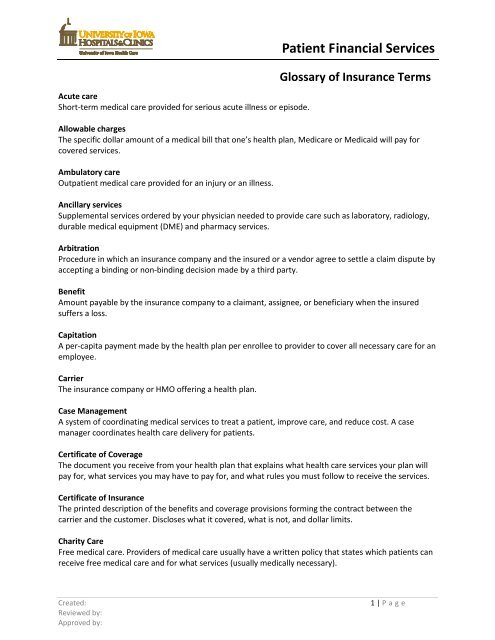Procedure/Job Aide Template - University of Iowa Hospitals and ...
Procedure/Job Aide Template - University of Iowa Hospitals and ...
Procedure/Job Aide Template - University of Iowa Hospitals and ...
Create successful ePaper yourself
Turn your PDF publications into a flip-book with our unique Google optimized e-Paper software.
Acute care<br />
Short-term medical care provided for serious acute illness or episode.<br />
Patient Financial Services<br />
Allowable charges<br />
The specific dollar amount <strong>of</strong> a medical bill that one’s health plan, Medicare or Medicaid will pay for<br />
covered services.<br />
Ambulatory care<br />
Outpatient medical care provided for an injury or an illness.<br />
Ancillary services<br />
Supplemental services ordered by your physician needed to provide care such as laboratory, radiology,<br />
durable medical equipment (DME) <strong>and</strong> pharmacy services.<br />
Arbitration<br />
<strong>Procedure</strong> in which an insurance company <strong>and</strong> the insured or a vendor agree to settle a claim dispute by<br />
accepting a binding or non-binding decision made by a third party.<br />
Benefit<br />
Amount payable by the insurance company to a claimant, assignee, or beneficiary when the insured<br />
suffers a loss.<br />
Capitation<br />
A per-capita payment made by the health plan per enrollee to provider to cover all necessary care for an<br />
employee.<br />
Carrier<br />
The insurance company or HMO <strong>of</strong>fering a health plan.<br />
Glossary <strong>of</strong> Insurance Terms<br />
Case Management<br />
A system <strong>of</strong> coordinating medical services to treat a patient, improve care, <strong>and</strong> reduce cost. A case<br />
manager coordinates health care delivery for patients.<br />
Certificate <strong>of</strong> Coverage<br />
The document you receive from your health plan that explains what health care services your plan will<br />
pay for, what services you may have to pay for, <strong>and</strong> what rules you must follow to receive the services.<br />
Certificate <strong>of</strong> Insurance<br />
The printed description <strong>of</strong> the benefits <strong>and</strong> coverage provisions forming the contract between the<br />
carrier <strong>and</strong> the customer. Discloses what it covered, what is not, <strong>and</strong> dollar limits.<br />
Charity Care<br />
Free medical care. Providers <strong>of</strong> medical care usually have a written policy that states which patients can<br />
receive free medical care <strong>and</strong> for what services (usually medically necessary).<br />
Created:<br />
Reviewed by:<br />
Approved by:<br />
1 | P a g e
Patient Financial Services<br />
Glossary <strong>of</strong> Insurance Terms<br />
Claim<br />
A request by an individual (or his or her provider) to an individual's insurance company for the insurance<br />
company to pay for services obtained from a health care pr<strong>of</strong>essional.<br />
COBRA<br />
Consolidated Omnibus Budget Reconciliation Act, a federal law in effect since 1986. COBRA permits you<br />
<strong>and</strong> your dependents to continue in your employer's group health plan after your job ends. If your<br />
employer has 20 or more employees, you may be eligible for COBRA continuation coverage when you<br />
retire, quit, are fired, or work reduced hours. Continuation coverage also extends to surviving, divorced<br />
or separated spouses, dependent children, <strong>and</strong> children who lose their dependent status under their<br />
parent's plan rules. You may choose to continue in the group health plan for a limited time <strong>and</strong> pay the<br />
full premium (including the share your employer used to pay on your behalf) plus a 2% administrative<br />
fee. COBRA continuation coverage generally lasts 18 months, or 36 months for dependents in certain<br />
circumstances.<br />
*See also State Continuation Coverage.<br />
Coinsurance<br />
Co-insurance refers to money that an individual is required to pay for services, after a deductible has<br />
been paid. In some health care plans, co-insurance is called "co-payment." Co-insurance is <strong>of</strong>ten<br />
specified by a percentage. For example, the employee pays 20 percent toward the charges for a service<br />
<strong>and</strong> the employer or insurance company pays 80 percent.<br />
Continuous Coverage<br />
Health insurance coverage that is not interrupted by a break <strong>of</strong> 63 or more days in a row. Employer<br />
waiting periods <strong>and</strong> HMO affiliation periods do not count as gaps in health insurance coverage for the<br />
purpose <strong>of</strong> determining if coverage is continuous. See also Creditable Coverage, Federally Eligible.<br />
Coordination <strong>of</strong> Benefits (COB)<br />
Rules <strong>and</strong> procedures that determine how health care claims are paid when you are covered by more<br />
than one health insurance plan. Together, the health plans cannot pay more than the charge for the<br />
services.<br />
Copayment<br />
Co-payment is a predetermined (flat) fee that an individual pays for health care services, in addition to<br />
what the insurance covers. For example, some HMOs require a $10 "co-payment" for each <strong>of</strong>fice visit,<br />
regardless <strong>of</strong> the type or level <strong>of</strong> services provided during the visit. Co-payments are not usually<br />
specified by percentages.<br />
Covered Expenses<br />
In health insurance, reimbursement for an insured's medically-related expenses; including, but not<br />
limited to surgery, medicines, hospitalization, ambulance service, <strong>and</strong> X-rays.<br />
Credentialing<br />
The review process used by an insurer or health plan to determine which health care providers are<br />
qualified to provide services to health plan members. Items such as the provider’s license, certification,<br />
malpractice insurance, <strong>and</strong> history are examined.<br />
Created:<br />
Reviewed by:<br />
Approved by:<br />
2 | P a g e
Patient Financial Services<br />
Glossary <strong>of</strong> Insurance Terms<br />
Deductible<br />
The amount an individual must pay for health care expenses before insurance (or a self-insured<br />
company) covers the costs. Often, insurance plans are based on yearly deductible amounts.<br />
Effective Date<br />
The date your insurance is to actually begin. You are not covered until the policies effective date.<br />
Elective procedure<br />
A medical procedure that a patient <strong>and</strong> doctor plan in advance for a condition that is not life<br />
threatening.<br />
Emergency care<br />
Medical care that is needed immediately to save your life or to prevent serious harm to your health.<br />
Emergency Medical Services (EMS)<br />
Emergency care provided by ambulance personnel such as EMTs (emergency medical technicians),<br />
paramedics, first responders or other authorized individuals.<br />
Exclusions<br />
Medical services that are not covered by an individual's insurance policy.<br />
Exclusive Provider Organization (EPO)<br />
Least st<strong>and</strong>ard type <strong>of</strong> insurance. Different EPOs have different rules. Some plans are more restrictive<br />
than others. Providers are contracted <strong>and</strong> agree to discount charges. Contracted providers are referred<br />
to as “exclusive” <strong>and</strong> in most cases members may only see exclusive providers.<br />
Explanation <strong>of</strong> Benefits<br />
The insurance company's written explanation to a claim, showing what they paid <strong>and</strong> what the client<br />
must pay. Sometimes accompanied by a benefits check.<br />
Family Practitioner<br />
A physician who provides primary health care for individuals <strong>and</strong> families.<br />
Fee-for-Service<br />
Traditional method <strong>of</strong> payment for health care services where specific payment is made for specific<br />
services rendered to the provider.<br />
Fully Insured Group Health Plan<br />
Health insurance purchased by an employer from an insurance company. Fully insured health plans are<br />
regulated by the state <strong>of</strong> <strong>Iowa</strong>.<br />
Gatekeeper<br />
The health care provider, utilization review, case management, local agency or managed care entity who<br />
determines if a patient should see a specialist or receive other non-routine services. The goal <strong>of</strong> the<br />
gatekeeper is to guide the patient to appropriate services while avoiding unnecessary care.<br />
Created:<br />
Reviewed by:<br />
Approved by:<br />
3 | P a g e
Patient Financial Services<br />
Glossary <strong>of</strong> Insurance Terms<br />
Group Insurance<br />
Coverage through an employer or other entity that covers all individuals in the group.<br />
Health Insurance<br />
Financial protection against all or part <strong>of</strong> the medical care costs to treat illness or injury. Health<br />
insurance may also include benefits for preventive health care to help you stay healthy.<br />
HMO<br />
Health Maintenance Organizations represent "pre-paid" or "capitated" insurance plans in which<br />
individuals or their employers pay a fixed monthly fee for services, instead <strong>of</strong> a separate charge for each<br />
visit or service. The monthly fees remain the same, regardless <strong>of</strong> types or levels <strong>of</strong> services provided,<br />
Services are provided by physicians who are employed by, or under contract with, the HMO. HMOs vary<br />
in design. Depending on the type <strong>of</strong> the HMO, services may be provided in a central facility or in a<br />
physician's own <strong>of</strong>fice (as with IPAs).<br />
Health Plan<br />
A policy <strong>of</strong> health insurance issued by a health maintenance organization, an insurance company, Blue<br />
Cross Blue Shield, a fraternal benefit society, or other authorized entity.<br />
Health Savings Account (HSA)<br />
Account with tax-deductible contributions, tax-free interest earned, tax-free withdrawals for qualified<br />
medical expenses, <strong>and</strong> annual carry-over without limit for both funds <strong>and</strong> interest. Typically used in<br />
conjunction with high-deductible insurance plans or no insurance. Medicare patients are not qualified<br />
for HSA.<br />
HIPAA<br />
A Federal law passed in 1996 that allows persons to qualify immediately for comparable health<br />
insurance coverage when they change their employment or relationships. It also creates the authority to<br />
m<strong>and</strong>ate the use <strong>of</strong> st<strong>and</strong>ards for the electronic exchange <strong>of</strong> health care data; to specify what medical<br />
<strong>and</strong> administrative code sets should be used within those st<strong>and</strong>ards; to require the use <strong>of</strong> national<br />
identification systems for health care patients, providers, payers (or plans), <strong>and</strong> employers (or sponsors);<br />
<strong>and</strong> to specify the types <strong>of</strong> measures required to protect the security <strong>and</strong> privacy <strong>of</strong> personally<br />
identifiable health care. Full name is "The Health Insurance Portability <strong>and</strong> Accountability Act <strong>of</strong> 1996."<br />
Hospice<br />
A facility or program that provides care for a terminally ill patient.<br />
Indemnity Plan<br />
Indemnity health insurance plans are also called "fee-for-service." These are the types <strong>of</strong> plans that<br />
primarily existed before the rise <strong>of</strong> HMOs, IPAs, <strong>and</strong> PPOs. With indemnity plans, the individual pays a<br />
pre-determined percentage <strong>of</strong> the cost <strong>of</strong> health care services, <strong>and</strong> the insurance company (or selfinsured<br />
employer) pays the other percentage. For example, an individual might pay 20 percent for<br />
services <strong>and</strong> the insurance company pays 80 percent. The fees for services are defined by the providers<br />
<strong>and</strong> vary from physician to physician. Indemnity health plans <strong>of</strong>fer individuals the freedom to choose<br />
their health care pr<strong>of</strong>essionals.<br />
Created:<br />
Reviewed by:<br />
Approved by:<br />
4 | P a g e
Patient Financial Services<br />
Glossary <strong>of</strong> Insurance Terms<br />
Independent Physician Association (IPA)<br />
Network physicians can practice in an IPA (Independent Physician Association), where you visit the<br />
doctor’s <strong>of</strong>fice for care. A staff model where the health care company maintains a health care center,<br />
staffed with physicians <strong>and</strong> complete with lab, X-ray, pharmacy <strong>and</strong> other specialist services under one<br />
ro<strong>of</strong>; or a combination <strong>of</strong> both, which is called a mixed model. CIGNA HealthCare <strong>of</strong>fers these types <strong>of</strong><br />
networks. Most <strong>of</strong> CIGNA HealthCare’s network plans also <strong>of</strong>fer specialized benefits, including mental<br />
health <strong>and</strong> substance abuse, pharmacy, dental <strong>and</strong> vision care.<br />
Individual Insurance<br />
Health insurance coverage on an individual, not group, basis. The premium is usually higher for an<br />
individual health insurance plan than for a group policy, but you may not qualify for a group plan.<br />
In-network<br />
Providers or health care facilities, which are part <strong>of</strong> a health plan's network <strong>of</strong> providers with which it<br />
has negotiated a discount. Insured individuals usually pay less when using an in-network provider,<br />
because those networks provide services at lower cost to the insurance companies with which they have<br />
contracts.<br />
Inpatient Care<br />
Care provided to a patient requiring a bed who has been admitted to a health care facility to receive<br />
services.<br />
Large Group Health Plan<br />
A health plan with more than 50 eligible employees.<br />
Lifetime Maximum<br />
The maximum amount a health plan will pay in benefits to an insured individual during that individual's<br />
lifetime.<br />
Limitations<br />
A limit on the amount <strong>of</strong> benefits paid out for a particular covered expense, as disclosed on the<br />
Certificate <strong>of</strong> Insurance.<br />
Long-Term Care<br />
Insurance policies that cover specified services for a specified period <strong>of</strong> time. Long-term care policies<br />
(<strong>and</strong> their prices) vary significantly. Covered services <strong>of</strong>ten include nursing care, home health care<br />
services, <strong>and</strong> custodial care.<br />
Managed Care<br />
A medical delivery system that attempts to manage the quality <strong>and</strong> cost <strong>of</strong> medical services that<br />
individuals receive. Most managed care systems <strong>of</strong>fer HMOs <strong>and</strong> PPOs that individuals are encouraged<br />
to use for their health care services. Some managed care plans attempt to improve health quality, by<br />
emphasizing prevention <strong>of</strong> disease.<br />
Managed Care Organizations (MCO)<br />
A health plan that seeks to manage care. Examples: HMOs <strong>and</strong> IPAs.<br />
Created:<br />
Reviewed by:<br />
Approved by:<br />
5 | P a g e
Patient Financial Services<br />
Glossary <strong>of</strong> Insurance Terms<br />
Maximum Dollar Limit<br />
The maximum amount <strong>of</strong> money that an insurance company (or self- insured company) will pay for<br />
claims within a specific time period. Maximum dollar limits vary greatly. They may be based on or<br />
specified in terms <strong>of</strong> types <strong>of</strong> illnesses or types <strong>of</strong> services. Sometimes they are specified in terms <strong>of</strong><br />
lifetime, sometimes for a year.<br />
Maximum Out-<strong>of</strong>-Pocket Cost / Out-<strong>of</strong>-Pocket Limit<br />
The total amount <strong>of</strong> money you may be required to pay each year for medical care under a health plan<br />
including deductibles, co-payments, co-insurance, etc.<br />
Medicaid (Title XIX)<br />
A health care program for people who meet certain income <strong>and</strong> other guidelines. Medicaid is paid for by<br />
federal <strong>and</strong> state dollars.<br />
Medical Assistance<br />
A Medicaid health care program for people who meet certain income <strong>and</strong> other guidelines. It is paid for<br />
by federal <strong>and</strong> state dollars.<br />
Medically Necessary Care<br />
Health care services that are generally accepted by health care providers to be appropriate to diagnose<br />
or treat a medical condition as well as preventative health services.<br />
Medicare (Title XVIII)<br />
A federal health insurance program for people over 65 <strong>and</strong> for certain people under 65 with disabilities<br />
or health conditions.<br />
Medicare Supplemental Insurance<br />
A secondary policy that covers certain medical expenses not fully covered by Medicare.<br />
Network<br />
A group <strong>of</strong> doctors, hospitals <strong>and</strong> other health care providers contracted to provide services to insurance<br />
companies’ customers for less than their usual fees. Provider networks can cover a large geographic<br />
market or a wide range <strong>of</strong> health care services. Insured individuals typically pay less for using a network<br />
provider.<br />
Nurse Practitioner (NP)<br />
A registered nurse specifically educated (generally Masters programs) <strong>and</strong> licensed to provide primary<br />
<strong>and</strong>/or specialty care.<br />
Out-<strong>of</strong>-Network Provider<br />
This phrase usually refers to physicians, hospitals or other health care providers who are considered<br />
nonparticipants in an insurance plan (usually an HMO or PPO). Depending on an individual's health<br />
insurance plan, expenses incurred by services provided by out-<strong>of</strong>-plan health pr<strong>of</strong>essionals may not be<br />
covered, or covered only in part by an individual's insurance company.<br />
Out-<strong>of</strong>-Pocket Costs<br />
Health care expenses not covered by an insurer or HMO, including deductibles, co-insurance, <strong>and</strong> copayments.<br />
Created:<br />
Reviewed by:<br />
Approved by:<br />
6 | P a g e
Patient Financial Services<br />
Glossary <strong>of</strong> Insurance Terms<br />
Out-<strong>of</strong>-Pocket Maximum<br />
A predetermined limited amount <strong>of</strong> money that an individual must pay out <strong>of</strong> their own savings, before<br />
an insurance company or (self-insured employer) will pay 100 percent for an individual's health care<br />
expenses.<br />
Outpatient<br />
An individual (patient) who receives health care services (such as surgery) on an outpatient basis,<br />
meaning they do not stay overnight in a hospital or inpatient facility. Many insurance companies have<br />
identified a list <strong>of</strong> tests <strong>and</strong> procedures (including surgery) that will not be covered (paid for) unless they<br />
are performed on an outpatient basis. The term outpatient is also used synonymously with ambulatory<br />
to describe health care facilities where procedures are performed.<br />
Participating Providers<br />
Health care providers who are under contract with an insurer or HMO.<br />
Physician Assistant (PA)<br />
A specifically trained physician extender who provides medical care under physician supervision.<br />
Point <strong>of</strong> Service (POS)<br />
POS is the most versatile type <strong>of</strong> insurance. Plans have “tiers”, also called “levels” or “options”.<br />
Members may select from these tiers for each service received. Each tier has different rules: Tier 1<br />
works like an HMO; Tier 2 works like a PPO in network <strong>and</strong> Tier 3 works like a PPO out-<strong>of</strong>-network. This<br />
is a method <strong>of</strong> influencing patients without restricting choice too much.<br />
Policy Limit<br />
The maximum amount a policy will pay, either overall or under a particular coverage.<br />
Pre-Certification (Pre-Admission Review)<br />
A review <strong>of</strong> an individual’s health care status or condition, prior to an individual being admitted<br />
to a hospital. Pre-admission reviews are <strong>of</strong>ten conducted by case managers or insurance<br />
company representatives (usually nurses) in cooperation with an individual’s health care<br />
provider, <strong>and</strong> or hospitals.<br />
Pre-cert nurses exchange clinical information with Insurance companies as well as continued<br />
stay review with documentation <strong>and</strong> number <strong>of</strong> days.<br />
Pre-Existing Condition<br />
A medical condition that is excluded from coverage by an insurance company, because the condition<br />
was believed to exist prior to the individual obtaining a policy from the particular insurance company.<br />
Pre-Existing Condition Exclusion Period<br />
The time during which a health plan will not pay for covered care relating to a preexisting condition.<br />
*See also Preexisting Condition<br />
Prepaid Health Plan (PHP)<br />
Entity that contracts on a prepaid, capitated risk basis to provide services that are no riskcomprehensive<br />
services, or contracts on a non-risk basis.<br />
Created:<br />
Reviewed by:<br />
Approved by:<br />
7 | P a g e
Patient Financial Services<br />
Glossary <strong>of</strong> Insurance Terms<br />
Preferred Provider Organization<br />
You or your employer receive discounted rates if you use doctors from a pre-selected group. If you use a<br />
physician outside the PPO plan, you must pay more for the medical care.<br />
Premium<br />
The amount that you <strong>and</strong>/or your employer pay for health insurance, usually paid in installments.<br />
Preventive Care<br />
Health care that focuses on healthy behavior <strong>and</strong> providing services that prevent health problems. This<br />
includes health education, immunizations, early disease detection, health evaluations <strong>and</strong> follow-up<br />
care.<br />
Primary Care<br />
Basic health care services rendered by physicians in general practice or in fields such as family practice,<br />
obstetrics, <strong>and</strong> pediatrics.<br />
Primary Care Providers (PCP)<br />
A health care pr<strong>of</strong>essional (usually a physician) who is responsible for monitoring an individual's overall<br />
health care needs. Typically, a PCP serves as a "quarterback" for an individual's medical care, referring<br />
the individual to more specialized physicians for specialist care.<br />
Prior Authorization<br />
Pre-approval for a specified service or procedure; used to determine if the proposed<br />
treatment is deemed medically necessary for the health <strong>of</strong> the patient.<br />
Provider<br />
Provider is a term used for health pr<strong>of</strong>essionals who provide health care services. Sometimes, the term<br />
refers only to physicians. Often, however, the term also refers to other health care pr<strong>of</strong>essionals such as<br />
hospitals, nurse practitioners, chiropractors, physical therapists, <strong>and</strong> others <strong>of</strong>fering specialized health<br />
care services.<br />
Quality Assurance<br />
Activities to ensure <strong>and</strong> improve the quality <strong>of</strong> medical care that is provided by reviewing the care <strong>and</strong><br />
working to correct any problems.<br />
Referral<br />
A referral is a pre-approval from a patient’s primary care physician to receive care from<br />
a different provider or facility. Health Maintenance Organizations (HMO) insurance<br />
plans require a referral (authorization) to obtain coverage for outside services. Insurance<br />
companies use varying terminology for referral such as ‘Gap Exception’ or ‘Exception <strong>of</strong><br />
Benefit. Some insurance plans have a point <strong>of</strong> service (POS) option which allows<br />
patients to seek services from a physician/hospital that falls outside the HMO network<br />
<strong>and</strong> pay a greater percentage/out <strong>of</strong> pocket for the services received from an out <strong>of</strong><br />
network health care provider.<br />
Created:<br />
Reviewed by:<br />
Approved by:<br />
8 | P a g e
Patient Financial Services<br />
Glossary <strong>of</strong> Insurance Terms<br />
Reinsurance<br />
Insurance by another insurer <strong>of</strong> all or a part <strong>of</strong> a risk previously assumed by an insurance company.<br />
(Webster)<br />
Reinsurance essentially is insurance for insurance companies (<strong>and</strong>, sometimes, for other organizations<br />
that face risk, such as employers that self-insure their employees' health care costs). As with so many<br />
other types <strong>of</strong> insurance policies, reinsurance is not activated until a deductible is met; <strong>and</strong> there is a<br />
"ceiling," or upper limit, on reinsurable expenses. Reinsurance policies also have coinsurance rates<br />
(amounts that the policyholder must pay for particular services) that apply to expenses between the<br />
deductible <strong>and</strong> ceiling.<br />
Insurers typically worry about two types <strong>of</strong> very large losses—aggregate losses for a group being above<br />
some overall level, <strong>and</strong> loss per insured person exceeding some threshold. Aggregate losses could<br />
exceed expectations if more group members had expenses above the average than was expected for the<br />
group. In this case, the insurer would not have set premiums high enough to cover those aggregate<br />
losses. To place a limit on their exposure to such expenses, insurers <strong>of</strong>ten purchase reinsurance. In such<br />
cases it is known as aggregate stop-loss reinsurance, since it puts a stop to overall losses above some<br />
level.<br />
Respite Care<br />
Providing patient care so the primary caregiver can rest or take time <strong>of</strong>f.<br />
Rider<br />
A modification made to a Certificate <strong>of</strong> Insurance regarding the clauses <strong>and</strong> provisions <strong>of</strong> a policy<br />
(usually adding or excluding coverage).<br />
Self-Insured Group Health Plans<br />
Plans set up by employers who set aside funds to pay their employees' health claims. Because<br />
employers <strong>of</strong>ten hire insurance companies to run these plans, they may look to you just like fully insured<br />
plans. Employers must disclose in your benefits information whether an insurer is responsible for<br />
funding, or for only administering the plan. If the insurer is only administering the plan, it is self-insured.<br />
Self-insured plans are regulated by the U.S. Department <strong>of</strong> Labor, not by the state <strong>of</strong> <strong>Iowa</strong>.<br />
Self-Pay Patients<br />
Individuals who pay out-<strong>of</strong>-pocket for the medical care they receive as they are not covered under an<br />
insurance plan or assistance program such as Medicaid. Tax Equity <strong>and</strong> Fiscal Responsibility Act <strong>of</strong> 1982<br />
(TEFRA): As a component <strong>of</strong> Medical Assistance, TEFRA helps families cover health care costs for their<br />
severely disabled children who would otherwise require institutional-level care.<br />
Subrogation<br />
The legal process by which an insurance company, after paying for a loss, seeks to recover the amount<br />
<strong>of</strong> the loss from another party who is legally liable.<br />
Tertiary Care<br />
Highly specialized medical care that may require the use <strong>of</strong> specialized medical facilities.<br />
Created:<br />
Reviewed by:<br />
Approved by:<br />
9 | P a g e
Patient Financial Services<br />
Glossary <strong>of</strong> Insurance Terms<br />
Third-Party Administrator<br />
Outside group that performs clerical functions for an insurance company. An organization, public or<br />
private, which pays or insures for the health care services on behalf <strong>of</strong> the beneficiaries or recipients.<br />
Underwriting<br />
Process <strong>of</strong> assessing <strong>and</strong> assuming the risk <strong>of</strong> enrolling an individual or a group in a health plan.<br />
Underinsured<br />
People with inadequate health insurance that does not cover all necessary medical care.<br />
Waiting Period:<br />
A period <strong>of</strong> time when you are not covered by insurance for a particular problem.<br />
Worker’s Compensation<br />
A state-m<strong>and</strong>ated program requiring employers to pay benefits <strong>and</strong> furnish medical care to employees<br />
for on-the-job injuries <strong>and</strong> to pay benefits to dependents <strong>of</strong> employees killed in the course <strong>of</strong><br />
employment.<br />
Created:<br />
Reviewed by:<br />
Approved by:<br />
10 | P a g e
















